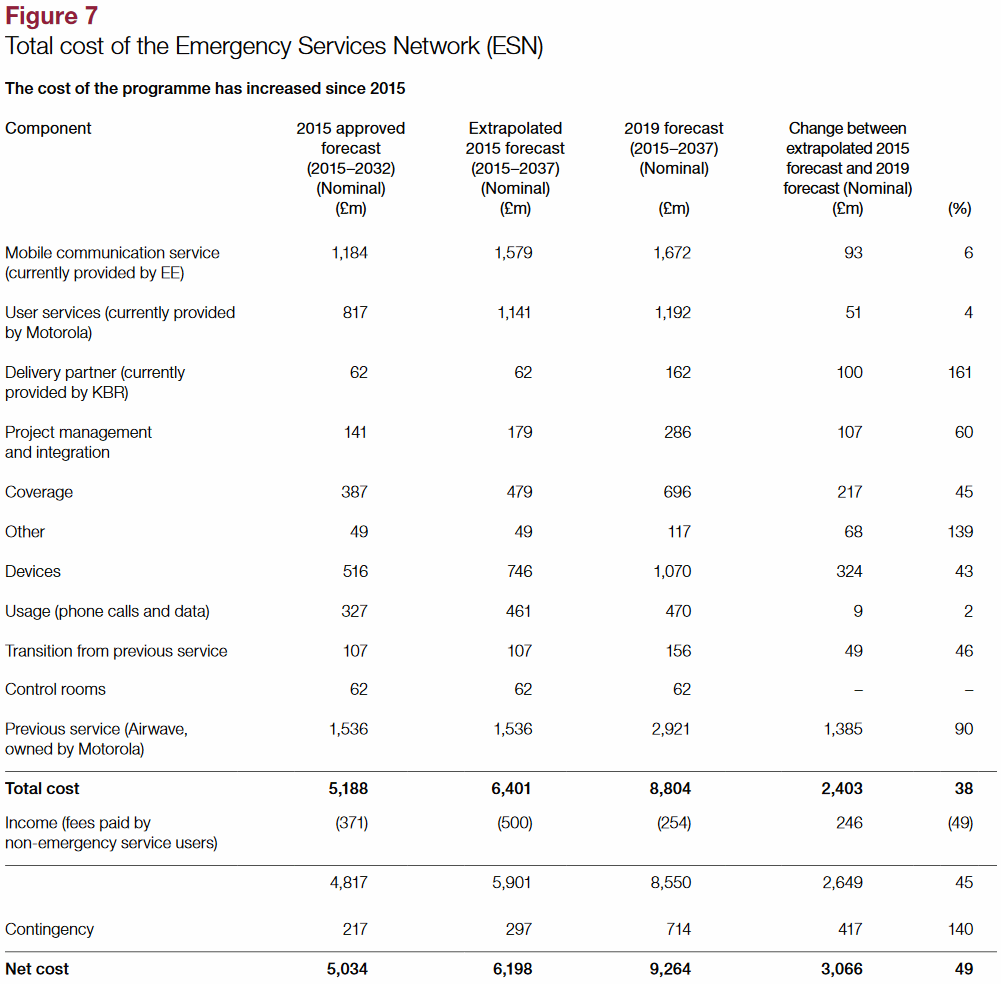4G Emergency Services Network Faces Huge UK Delay and £9.3bn Cost
The National Audit Office (NAO) has today issued a damning report into the Home Office’s handling of the new 4G (EE) based Emergency Services Network (ESN), which will now cost a total of £9.3bn (£3.1bn more than forecast in 2015) and it will be July 2029 before the financial benefits outweigh its costs (7 years late).
At present 200,000+ police, fire and other emergency service(s) users interface via the Motorola-owned Airwave network, which is believed to cost the UK around £3bn and harnesses the TETRA (Terrestrial Trunked Radio) network technology. However TETRA is slow (dialup / ISDN like data speeds but it could go a bit faster with upgrades) and expensive, although it does deliver excellent voice coverage (c.97% geographic reach).
The high cost of Airwave is often highlighted as one of the main reasons why the government in 2015 decided to replace it with 4G (the first country to do so). The Home Office previously expected that emergency services would start using ESN in September 2017, allowing Airwave to be replaced in December 2019, but this isn’t how things have turned out and in 2017 a review identified several key problems (see below).
Advertisement
Take note, 5 minutes is the time the Home Office expects ESN to save each police officer on each shift, compared with current arrangements. Believe it or not, this is considered to be “the largest economic benefit expected“. Just enough time to make a cup of tea. Worth it.
Five Causes of the UK ESN Delay
• The failure of the delivery partner (KBR) to provide planning and collaboration between the other contractors after its role was downgraded.
• Motorola and EE had solutions based on different versions of the technical standards.
• Disagreement on the accountability for systems integration and technical design. The review found that the Home Office and Motorola had not agreed the “true scope” of Motorola’s role in integrating ESN systems “end-to-end”.
• Challenges in locking down the specification for software and user services. There was no effective process for signing off software developed by Motorola in a timely manner.
• Late delivery of the ‘related projects’, which the Home Office kept separate from the main contracts and controlled itself. These include the handsets and vehicle equipment that the emergency services will use, providing ESN on the London Underground and an air-to-ground service for helicopters and aeroplanes.
At this point it’s worth highlighting that the rollout of EE’s core 4G network is said to be “slower than originally planned” and overall network coverage will not be sufficient in order to completely turn off the old Airwave system until December 2022 (this is the “minimum” forecast delay). Some £1.4bn of the extra costs now being forecast will thus come from the fact that Airwave has had to be extended in order to ensure a smooth transition on to 4G.
However EE’s contract does not include all aspects of ESN coverage. For example, the Home Office is responsible for commissioning 292 masts to be built in areas not covered by the market. By March 2019, only two were reported as complete. Work had started on building coverage for the London Underground, and work on a network to provide coverage in the air (above 500 feet) has not started.
A quick look at how the original 2015 vs 2019 cost forecasts have changed helps to show which areas have had the biggest impact.
Advertisement

Amyas Morse, Head of the NAO, said:
“The success of the Emergency Services Network is critical to the day-to-day operations of our emergency services that keep us all safe. The Home Office needs a comprehensive plan with a realistic timetable that properly considers risks and uncertainties. It has already been through one costly reset and is in danger of needing another unless it gets its house in order.”
In short, the NAO does not think the Home Office has demonstrated that it understands the challenges emergency services face in introducing ESN, such as incurring extra costs by having to switch. Emergency services do not yet know how much money they will need to invest in infrastructure to improve the coverage or to make control rooms compatible. Some worry that this could place further financial pressure on other services they provide.
The NAO said there are also a number of commercial risks to ESN. The Home Office is currently renegotiating the programme’s main contracts with Motorola and EE, but these are behind schedule. “Motorola needs to be carefully managed as it is both a main supplier to ESN and the owner of Airwave … It could therefore benefit financially from further delays if Airwave is extended,” said the report.
Furthermore the Home Office does not currently have the capability it needs to integrate and fully test ESN, which comprises multiple pieces of technology that must be made to work together.
Advertisement
a. The Home Office needs to test its overall programme plan, to determine whether the new schedule for launching ESN and shutting down Airwave is achievable. It should prepare a comprehensive plan as soon as possible, covering all key elements of this complex programme, to ensure it develops realistic and tested assumptions about the time required for each element and the dependencies between them. The plan should be used to establish whether the Home Office can achieve the December 2022 date for switching off Airwave. It should be appraised by the Home Office’s new supplier of “programme advisory and delivery services”, expected to be appointed in mid-2019, and should be agreed by ESN’s sponsors, users and suppliers.
b. The Home Office needs to decide how the vital work to integrate all the ESN technology will be carried out. It should clearly set out whether this technical integration is part of the new contract for “programme advisory and delivery services” and if not, whether the programme team can do the technical integration itself or needs additional technical support.
c. The Home Office needs to work with other sponsors and users to develop the arrangements for managing ESN once it is fully operational. How the ESN service will be governed and managed when it is a live service is still not clear, although we identified this risk in our report in 2016. This leads to a continuing risk that users’ requirements will not be met.
d. The Home Office should develop a contingency plan that sets out what it will do if technology on which the overall ESN programme is dependent does not work. The contingency plan should be linked to key delivery milestones for the contractors and include clear criteria for activating it.
Once completed some 470 organisations are expected to use ESN. This includes all 107 police, fire and ambulance services in England, Scotland and Wales, and another 363 other organisations in the public, private and third sectors are also expected to use the network and contribute to its costs.
Mark is a professional technology writer, IT consultant and computer engineer from Dorset (England), he also founded ISPreview in 1999 and enjoys analysing the latest telecoms and broadband developments. Find me on X (Twitter), Mastodon, Facebook, BlueSky, Threads.net and Linkedin.
« Court Ruling Favours ISP GibFibre in Gibraltar Broadband Battle

















































Comments are closed